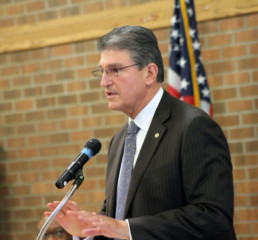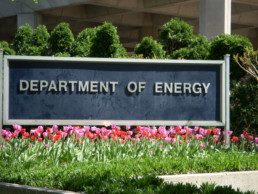Opponents Of Joe Manchin’s Permitting Reform Demonstrate Why We Need Permitting Reform
By Brentan Alexander, PhD, President
Less than one week ago, Senators Joe Manchin and Chuck Schumer shocked Democrats and Republicans alike with their announcement of a reconciliation package that included significant climate and energy provisions: the Inflation Reduction Act of 2022. Although much reporting has been focused on the specifics of that package, Manchin conditioned his support on Democratic leadership taking up environmental permitting reform in a separate bill later this session. Last week, Manchin released a 1-page summary of his proposed permitting reform bill, outlining the reforms he seeks and the benefits it will provide to clean and fossil technologies alike. Environmental groups were quick to jump on the proposal as an ‘attack,’ singling out the fossil provisions in particular. Although the proposed reforms are not perfect, there should be no doubt that broad-based permitting reform is needed to advance the clean agenda, and this bill is our best chance to get it. Without it, the tactics pioneered by the environmental movement will continue to be used to subvert the clean infrastructure of tomorrow.
The environmental movement has been incredibly successful over the last half-century at advancing legislation and policies that restrict project development through the careful review of environmental impacts. A landmark 1970s law, the National Environmental Policy Act (NEPA), requires project developers across a range of industries to tally and mitigate impacts on air, water, noise, traffic, and more.
Fifty years in, NEPA has stopped countless environmentally destructive projects from breaking ground and has significantly slowed the process through which new projects get permitted and built. NEPA, however, has also shown itself to be vulnerable to abuse. The law fails to provide guidance for how to balance the trade-offs inherent in any development, and the qualitative nature of many environmental impacts, combined with the sheer number of impacts that must be mitigated, invites lawsuits and challenges. Opposition groups can readily contend that a project has not properly accounted for its impacts or that the project benefits have been overstated. Lawsuits challenging project reviews can tie up a developer in costly litigation for years, effectively killing projects.
The result has been a perversion of the law’s original intention and a weaponization of NEPA from groups on both sides of the aisle. Proposals from bike lanes to enrollment increases at UC Berkeley have been knocked off-course by bad-faith uses of NEPA. The law, designed to prevent bad projects from getting built, instead is preventing any project from getting built. It has become a defender of the status-quo, which is a problem when the status-quo is destroying the planet.
Surprisingly, it’s often the very environmental groups cheering clean energy investments who wield NEPA lawsuits against clean energy infrastructure. The fundamental problem is that any technology has environmental and social impacts of one form or another. A project that sucks CO2 from the air can incentivize the continued operation of a fossil-fired facility in underrepresented communities. Nuclear facilities produce long-lasting radioactive waste. There is no silver bullet to the climate and environmental justice crises; no one technology or solution will satisfy every audience. For example, just two months ago, 73 groups penned a letter to California Governor Gavin Newsom outlining their opposition to the widespread adoption of a variety of clean technologies, including renewable fuels, carbon capture from power plants and other industrial facilities, and direct-air capture. The reality is that most projects will find themselves with at least one group in opposition, and only a single opposition group is needed to weaponize NEPA and derail a project.
Without reform, abuses will continue and good projects will be killed. Even when the Inflation Reduction Act becomes law, the incredible investment in clean and renewable technologies it will enable will only bear fruit if projects that make actual impacts are built. Manchin’s goal of tying energy investment with environmental permitting reform is good policy: Neither reform is likely to be successful without the other.
###
Build Back Better Isn’t Enough: Enact Regulatory Reform to Unlock Climate Investment
By Brentan Alexander, PhD, President
Between Build Back Better, the Green New Deal, and the Infrastructure Bill, there has been no shortage of ambitious policy proposals to move the US economy towards a cleaner, more climate friendly footing. These various programs share a policy structure wherein tax incentives, grants, and other dollars are used to spur investments in climate technology and infrastructure. Investments in new research and infrastructure alone, however, won’t be enough to supercharge progress on climate because a web of regulatory approvals and permits will continue to hold back good projects. These rules, established over decades by many of the same voices that now claim an eagerness to tackle climate issues, add cost and complexity to the development and deployment of new infrastructure, hindering the very progress we need. A recent article by Alex Trembath, posted on City Journal, gives a name to this phenomenon: “cost-disease environmentalism.” A failure to address it will unnecessarily hinder the development of next-generation technology and infrastructure.
“Cost-disease environmentalism” refers to the process of enacting policy to stimulate demand, such as grants and tax incentives, without bothering to address the structural problems that inhibit supply. It is a close cousin of NIMBY-ism (“not in my backyard”), driving policymakers to advocate for money to support clean energy adoption while also supporting regulatory regimes that inhibit permitting and construction of those same clean energy projects. The most obvious culprit is the National Environmental Policy Act (NEPA) and the variety of state-level companion laws enacting its requirements. These regulations are designed to ensure new developments of all types consider the surrounding environment as part of the permitting and approval process. A noble goal for sure, but over time many have learned to weaponize these laws under the cover of ‘protecting local character’ or ‘maintaining local control’ in order to discourage or disrupt any development at all. The California Environmental Quality Act (CEQA), signed into law by Ronald Reagan, has been used to block everything from bike lanes to enrollment increases at UC Berkeley. Many have bemoaned the inability of the United States to build large infrastructure the way China or Europe does; the regulatory burden is a key reason why.
These laws have been a cornerstone of the environmental movement for nearly half a century and are widely viewed among environmentalists as sacred protectors of the air we breathe and water we drink. Conversations about wholesale changes to these programs are dismissed as driven by a deregulation agenda aimed at plundering the natural world. Examples of polluting projects that would have been greenlit if not for the protections these laws provide are used to justify their existence. The problem is that these laws, enacted to defend the environment, are instead routinely used to defend the status quo. Why protect the status quo when it’s playing a key role in destroying the planet?
Environmental regulation should be focused on reaching the cleaner world we seek, not freezing the world as we have it today. Projects with obvious climate merit should have a streamlined permitting and approvals path, without risk of protracted legal battles and delays. Moderate innovations in regulatory policy would lower the cost and risk of developing climate-friendly projects, driving investment and deployment without the need to spend a single taxpayer dollar.
There are examples of this working. In California, residential rooftop solar has seen explosive growth over the last decade, in part thanks to demand-side financial incentives including the federal investment tax credit and the state-level net-energy metering program. But equally significant in driving adoption were reforms on the supply-side that eased the permitting process for residential solar. California established a standard permit application for residential solar. When followed, an over-the-counter ministerial review is the only approval needed. Various laws did away with laborious planning department approvals, eliminated HOA restrictions on solar, exempted the value of the solar system from property tax adjustments, and removed the need for structural engineers, electrical engineers, and other specialists to develop and submit a permit. An expensive, multi-week process costing thousands in time and fees was replaced with a templated “standard plan” that takes under an hour to complete.
More action of this type is needed. Government tax breaks, grants, and incentives for new technologies and projects are necessary and welcome supports for the climate movement; realizing the full impact of these dollars requires coupling them with a regulatory framework that streamlines project approvals and permits for climate infrastructure.
###
Volcanic Eruptions Can Cool the Climate, But Hunga-Tonga Won’t
By Brentan Alexander, PhD, President
The eruption of the Hunga-Tonga-Hunga-Ha'apai volcano last weekend sent a massive cloud of ash high into the atmosphere and generated a tsunami that impacted much of the Pacific Rim. As of last week, the damage from the eruption to Tonga and surrounding nations was just beginning to become known, with widespread destruction reported on the islands. Scientists have long known that large volcanic eruptions can have an immediate and years-long impact on the global climate, and an entire field of study has evolved to better understand the mechanisms. Early data from last weekend’s eruption, however, indicated it was much too small to have any meaningful impact on climate change.
One of the best known and studied volcanic events linked to a decline in global temperatures is the 1991 eruption of Mount Pinatubo in the Philippines. Over the course of three days, Pinatubo released somewhere between six and 22 million tons of sulfur dioxide into the atmosphere, roughly equivalent to 20% of man-made SO2 released last year. Sulfate aerosols are reflective, scattering sunlight and reflecting some of it back to space. With sufficient quantities of these compounds in the atmosphere, enough light can be reflected away from earth to cool the planet.
Volcanic sulfates are especially good at impacting global climate. Man-made emissions, such as from power plants, are emitted at or near ground level and tend to remain in the atmosphere on the order of days or weeks, joining with water in the air and returning to earth as acid rain. During a massive volcanic eruption, however, much of the SO2 is lofted many miles up in to the stratosphere, above most clouds and weather, where they are only removed slowly over time through gravitational settling or large scale circulation. At that altitude, the aerosols remain for months to years. Pinatubo resulted in a global temperature decline of nearly one degree Fahrenheit during the year following its eruption.
Scientists studying this phenomenon have begun to research the purposeful release of reflective aerosols to cool the planet. So-called geoengineering would allow humankind to avoid the worst impacts of climate change by adding planet-wide cooling technology to our toolset. The technology isn’t a panacea, as even the most ardent supporters of the approach would agree. For one, sulfur compounds in the upper atmosphere have also been shown to attack the ozone layer, and much of the sulfur eventually returns to the surface as acid rain. The approach also does nothing to inhibit other environmental impacts of anthropogenic carbon emissions, such as ocean acidification. Global cooling through geoengineering or the natural volcanic equivalent is no silver-bullet for climate change. Instead, it's just one bad option in a narrowing set of tools at our disposal to avoid the worst, and scientists are working to understand the impacts and implications in case it becomes the least-bad option.
Hunga-Tonga-Hunga-Ha'apai, however, likely won’t serve as a test case, and won’t buy us time. Early data from Earth-observing satellites indicates that total sulfur dioxide emissions are roughly one to two percent of Pinatubo and nearly an order of magnitude too small to have any measurable climate impact. The eruption may still continue and more planet cooling gases could be released, but at this point our continued march to warmer temperatures and higher seas remains unabated. The usual solutions, from renewable energy to green hydrogen to carbon capture, remain our best tools to combat the climate crisis.
###
The New Infrastructure Bill Looks to Solve a Clean Energy ‘Valley of Death’
By Brentan Alexander, PhD, President
Last week, the US House of Representatives finally advanced the Infrastructure Investment and Jobs Act, capping a years-long effort to pass a variety of important domestic programs. The many provisions in the 2,740 page bill include billions of dollars in funding to support clean energy technologies and fight climate change through investments ranging from electric vehicle infrastructure to public transit. Much more is needed to avert climate catastrophe. However, there is one section of the infrastructure bill that will at least unleash numerous climate-friendly technologies: the Office of Clean Energy Demonstrations.
The road from technology research and development to massive deployment at scale is long and arduous. Along the way, innovators face a number of challenges and roadblocks, so-called “valleys of death,” that must be overcome in order to achieve success. Early on, funding must be sought to advance lab-grown ideas for continued research and development. For technologies designed to fight climate change such as direct-air carbon capture and industrial green hydrogen, reaching the broader market means raising hundreds of millions of dollars from low-cost institutional capital sources for each single deployment of their technology.
Traditionally, government support programs in the US for climate-friendly infrastructure have been aimed at the valleys of death on either end of this development and commercialization pathway. Grant programs, including from the highly successful Advanced Research Projects Agency - Energy (ARPA-E), have focused on early-stage research and development. Deployment programs, such as the loan guarantees awarded by the Loan Programs Office (LPO) under the Department of Energy (DOE), have supported projects and technologies proven enough to be ready for commercial-scale deployments.
Between these stages there is a yawning gap. Innovators that have developed a working technology through research activities find themselves unable to attract the financing needed for their commercial deployments without first de-risking their technology at large scales. Therefore, climate technologies face a catch-22 at this stage in their growth: Large-scale demonstration is needed to prove technology and unlock capital, but capital is needed to fund large-scale demonstration. It’s a unique problem not faced elsewhere, including in software, where code developed in a garage can be scaled to billions of users worldwide with the press of a button. Traditional risk-capital sources, from venture capital to private equity, are poorly placed to fill the gap and fund demonstration projects due to a mismatch between their investment models, the capital intensity of clean infrastructure, and the comparatively long time horizons for returns. Whereas government programs could fill in for the private markets, those aimed at this space have been limited: ARPA-E’s SCALEUP program has deployed $75 million in total since its inception, and other programs like the $200 million investment in the Petra Nova carbon capture project were essentially one-offs.
Into this void steps the soon-to-be-formed Office of Clean Energy Demonstrations. Established under the DOE, this new office includes just under $21.5 billion in funding to be deployed over the next few years. Its formation is a significant achievement and comes with great promise. Its mandate is designed to enable the demonstration of next-generation climate technologies and position these solutions for later large-scale commercial deployment, ideally financed by private markets.
Achieving success, however, is not guaranteed. Like any government program born of compromise, the budget for this new initiative has already been allocated to specific industries and solutions: approximately $500 million for energy storage demonstrations, $2.5 billion for advanced nuclear, $3.5 billion for carbon capture, $8 billion for hydrogen, and $5 billion for the electric grid. This structure will limit the program’s ability to allocate resources to the most impactful solutions dictated by developments in technology and the marketplace. Further, the office will require DOE oversight of the execution of programs funded by the office. Oversight ensures careful stewardship of public dollars, however if taken too far it can limit the flexibility of technology developers, stifling innovations and slowing deployments.
Finally, locating this program within the DOE risks igniting bureaucratic turf wars that could undermine program objectives and exposes the office to shifts in the political climate. Run poorly, this new office could suffer the fate of LPO, which wandered in the wilderness for years after the public failure of Solyndra (though that was followed by a recent reinvigoration). Run well, the office could equal or surpass the impact of bipartisan-backed ARPA-E by funneling billions of dollars in needed resources to climate innovators ready to prove their technologies and deploy at scale.
Many of the most impactful programs for climate are awaiting the passage of the companion reconciliation bill still working its way through Congress. From tax credits for carbon capture to investments in clean energy deployment, the reconciliation bill will put billions of dollars more to work to fight climate change. Those billions, in addition to the billions of dollars in the private sector earmarked for ESG-positive investments, will flow toward good technologies with a demonstrated track-record. The Office of Clean Energy Demonstrations has the potential to accelerate the new energy technologies we need to ensure all those billions of dollars are put to the most effective use.
###
The Shortest Path to Circular Plastics Is Through the Chemical Companies
By Brentan Alexander, PhD, Chief Science Officer & Chief Commercial Officer and Brad Price, Principal Engineer
The last decade has seen a notable increase in public awareness of the severe impact created by the dumping of waste plastics in the environment. Images of trash covered beaches and videos of wildlife injured by plastic pollution have provided compelling visual evidence that our single-use economy is quite literally trashing our planet. Governments are starting to respond to the problem, with strategies ranging from plastic product bans to taxes, and technologies aimed at enabling circular plastics are coming to market. Enabling this transition to a circular economy requires the cooperation of the large chemical companies that make the vast majority of our plastics, and most are already on board.
It’s natural to scoff at the notion that these large multinational producers of plastic materials are a core part of a circular future. These companies, such as Chevon Phillips Chemical, Dow, and SABIC, can either directly trace their formation back to fossil-oil companies or have significant collaborations with fossil-oil interests. They’ve also used many of the same dirty tricks from the oil and gas industry: In 2020, NPR and PBS Frontline published an investigation detailing the efforts by the plastics industry in the 1980s to improve the image of plastics by adopting the now-ubiquitous three-arrow recycling triangle, despite the fact that the industry was well aware that the actual recycling of the plastic itself was either economically unviable or technically unfeasible. The parallels to the climate-denialism of the oil majors, wherein Exxon and others actively discouraged, hid, or obfuscated the evidence of human-caused climate change, are obvious.
The drive to enable circular plastics, however, is fundamentally different than the efforts to decarbonize our energy system and eliminate fossil fuels. Changing from coal, oil, and natural gas to renewable energy sources represents a fundamental attack on the future of the fossil energy majors. Circular plastics, on the other hand, are entirely compatible with the business models of the chemical giants: They take a hydrocarbon feedstock and use petrochemical processes to make plastic pellets. Switching from a fossil-derived hydrocarbon feedstock to a feedstock derived from chemically recycled plastics is no change at all. These companies have no threat of stranded assets, major business pivots, or substantial facility redesigns. To the contrary, the rapidly expanding demand for recycled plastic material represents a business opportunity for these companies on which they are eager to capitalize. The better analogy is the Montreal Protocol, in which refrigerant manufacturers that made ozone-destroying chlorofluorocarbons (CFCs) were central to enabling a new generation of chemicals without the same destructive impact. These companies were happy to sell a new class of refrigerants that didn’t damage the ozone layer because they were already in the business of selling refrigerants. So too are plastic manufactures fully aligned with a future built on recycled plastics.
The proof that the shift is underway can be found in the public releases of these major corporations. SABIC, Saudi Arabia’s national petrochemical company, is already selling circular plastic material at commercial scale under the TrueCircle™ brand name through its partnership with Plastic Energy. Construction is underway at Eastman Chemical’s $300+ million dollar facility to chemically recycle PET, which is expected to start up in 2022. Recent patent applications and announcements reveal that ExxonMobil is developing its own proprietary process for waste plastic pyrolysis. Chevron Phillips Chemical (CPChem), the joint venture between Chevron and Phillips 66, has entered into supply agreements with three separate startups commercializing waste plastic pyrolysis technologies. And the largest waste plastic pyrolysis plant in the world from Brightmark (an NER client) is nearing completion in Ashley, Indiana, with more larger plants on the way.
These companies aren’t spending hundreds of millions of dollars because they have suddenly become responsible environmental stewards. Rather, their investments are being driven by a changing regulatory and market environment that is providing the economic driver needed to make these investments pay off. Maine recently signed an Extended Producer Responsibility (EPR) bill into law that places the financial responsibility for recycling programs on the producers of plastic packaging. Other states are considering minimum recycled content mandates to require the use of recycled plastic material. Similar laws are under consideration in statehouses across the country. In the European Union, the most ambitious and impactful program came into force on January 1, 2021, when the bloc implemented an €0.80 per kilogram tax on non-recycled plastic waste.
These companies are anticipating further market growth as more regulatory programs are put in place. This doesn’t make chemical corporations full allies of the environmental movement, especially since some proposed policies will impact their bottom line. For starters, their motivations include the continued growth in plastic production globally and ever-increasing rates of plastic usage. For the developing world most impacted by plastic pollution and waste, plastics made from recycled materials pollute the beach just the same. Policies that address plastic pollution do not fully overlap with those that encourage waste plastic recycling. In many cases, plastics should be replaced by more environmentally friendly materials, an outcome that the plastics manufacturers will surely fight to avoid.
But eliminating plastic waste by eliminating plastics is not a reasonable or realizable goal. Plastics improve our quality of life, they are physically resilient, relatively low cost (even with the additional costs associated with circular material), have a wide range of uses and applications, and they perform better than competing materials. They are not going to go away. Successfully dealing with plastic’s environmental impact requires enabling circularity for the plastics that will continue to be used in our modern economy. Achieving this goal doesn’t require slaying the plastic behemoths. Instead, the fastest route to circularity lies with them—despite their checkered environmental record—and governmental policies, which need cultivation to fully enable the circular plastic revolution.
###
The Supreme Court Deals Ethanol a Blow by Undermining the Renewable Fuel Standard
By Brentan Alexander, PhD; Chief Science Officer & Chief Commercial Officer
In June, the US Supreme Court ruled on a protracted legal and political fight that has pitted two pillars of the Republican base against each other since 2018. The case, HollyFrontier Cheyenne Refining, LLC v. Renewable Fuels Association, involved a small refinery in Wyoming that sought relief at the court from a lower court ruling restricting the authority of the US Environmental Protection Agency (EPA) to provide relief to refiners under the Renewable Fuel Standard (RFS). The Supreme Court, in a 6-3 ruling, granted that relief and gave small refiners a win in their ongoing battle to weaken the RFS.
The RFS was established by Congress with the Energy Independence and Security Act of 2007. Formulated during a time of falling US oil production, the RFS mandates blending requirements in the domestic fuel supply for biofuels, primarily corn-ethanol. The legislation has an unusual set of supporters from across the ideological spectrum, as it offsets the use of fossil-based fuels while also providing immense economic benefits to Middle America. Under the RFS, the EPA sets annual “Renewable Volume Obligations” for a variety of biofuels that refiners must blend into finished fuels. To track compliance and enable burden sharing, a market-based system allows obligated parties to trade compliance credits (RINs). The D6 RIN, which relates to corn-ethanol, underpins an ethanol industry that generated more than $46 billion in revenues in 2018 alone.
The cost of the RINs is borne by refiners (and eventually the consumer), who must purchase sufficient RINs to "retire" with the EPA. When the RFS was established, Congress was concerned that the cost of compliance could put small refiners out of business. As a result, they exempted small refiners from RFS mandates for the early years of the program (through 2011) and further established a waiver process to further exempt qualifying refiners from the obligations of the RFS after this initial period if compliance would lead to "disproportionate economic hardship" for the refiner.
This bar was not reached by many petitioners during the Obama years, but upon the start of the Trump presidency in early 2017, the floodgates were opened. The number of waivers granted to refiners skyrocketed from under 10 to over 30 between 2016 and 2018. Large refiners were given waivers, eliminating overnight billions of gallons of ethanol demand. The EPA failed to increase mandates on the remaining obligated refiners to compensate for this reduced demand. Prices for ethanol and the D6 RIN collapsed, and many ethanol plants closed as a result. Chuck Grassley (R-IA) complained that the EPA "screwed us." Unsurprisingly, the ethanol industry sued, starting the journey that led to last week’s Supreme Court decision.
The case came down to the meaning of the word “extension,” which I previously wrote about here. The statutory language allows a “small refinery [to] at any time petition for an extension of the exemption.” Lower courts ruled that an extension is only meaningful if there is a valid in-force exemption to extend in the first place. Under this logic, any lapse in an exemption eliminates any further ability to extend, restricting exemptions to refiners who had valid and continuously granted exemptions from the start of the RFS. Since most exemptions granted under the Trump Administration were to refiners without active exemptions, this decision invalidated a large number of waivers, a major win for the ethanol industry.
The Supreme Court overruled this interpretation. Writing for the majority, Justice Gorsuch found that the ordinary meaning of “extension” does not imply a continuity of the exemption, comparing the situation to a request for an extension on homework. Gorsuch wrote, "Think of the forgetful student who asks for an 'extension' for a term paper after the deadline has passed. The tenant who does the same after overstaying his lease, or parties who negotiate an 'extension' of a contract after its expiration.”
The win for the refiners undercuts the RFS, opening it to further political meddling. With a change in administration, scores of refiners with prior exemptions could apply and get their waivers reinstated, eviscerating ethanol demand. Worse still, an unfriendly administration could simply undo the RFS by rolling back mandates, waivers or not: The EPA is charged under the RFS with setting the blending mandates annually, and the statute provides no guidance on appropriate blend levels after 2022.
It’s too soon to say how the ruling will impact the market and the value of the D6 RIN. Even before this ruling, small refiners had slowed their RIN purchases considerably in the hope of a win, pulling their demand from the market. Prices dropped around 6% after the Supreme Court decision was released, bringing the D6 RIN price to $1.55, down from its 2021 high but still roughly double its value from the start of the year. Markets are likely factoring in the stability of the Biden Administration coupled with continued increases in ethanol demand as COVID impacts ease and oil demand recovers. The RFS seems safe for the near future, but the fate of the program after 2024 remains uncertain.
###
Oil and Ethanol Fight at the Supreme Court Over the Word “Extension”
By Brentan Alexander, PhD; Chief Science Officer & Chief Commercial Officer
A protracted legal and political fight that has pitted two pillars of the Republican base against each other reached its apex last week as the Supreme Court heard arguments in HollyFrontier Cheyenne Refining, LLC v. Renewable Fuels Association. At issue is the authority of the US Environmental Protection Agency (EPA) to provide relief to refiners under the Renewable Fuel Standard (RFS), which mandates blending requirements in the domestic fuel supply for biofuels, primarily corn-ethanol. Refiners argue that EPA’s authority (including to offer waivers) is broad, while the farm lobby counters that the authority is limited. The outcome of the case rests on how the nine justices interpret the meaning of the word “extension.” Their decision has the potential to enormously affect the value of ethanol in the US, directly driving corn prices and economies in the US heartland.
The RFS regulation was established by Congress with the Energy Independence and Security Act of 2007. Formulated during a time of falling US oil production, the RFS biofuels blending requirement strategy was seen both as an economic benefit to Middle America and a way to fortify domestic energy security. Under the RFS, the EPA sets annual “Renewable Volume Obligations” for a variety of biofuels that refiners must blend into finished fuels. To track compliance and enable burden sharing, the RFS established a market-based system that allows obligated parties to trade compliance credits (RINs). These RINs have a fluctuating value depending on supply and demand of biofuels in the market, and the D6 RIN, which relates to corn-ethanol, has been an important economic driver for growers in the Midwest. The program underpins the ethanol industry, which generated more than $46 billion in revenues in 2018 alone.
The cost of the RINs is borne by refiners (and eventually the consumer), who must purchase sufficient RINs to ”retire” with the EPA to satisfy their mandate. To aid small refiners from the added compliance costs, the RFS includes a waiver process designed to exempt qualifying refiners from the obligations of the RFS. Through a petition to the EPA, qualifying refiners can be granted temporary exemptions from blending mandates if the EPA, in consultation with the Department of Energy, finds that RFS compliance would lead to “disproportionate economic hardship” for the petitioner.
The difficulty for corn growers is that this exemption program was expanded considerably during the Trump administration. The number of waivers granted to refiners skyrocketed from under 10 to over 30 in the first two years of the administration. Even large refiners were given waivers, and the EPA failed to increase mandates on other refiners to compensate for the missing gallons, effectively reducing demand for biofuels by billions of gallons overnight. Prices for ethanol and the D6 RIN collapsed. Many ethanol plants closed as a result. Incensed, Chuck Grassley (R-IA) noted that the EPA “screwed us” and the lobbyists for farmers and ethanol producers unloaded criticism on administration officials. A lawsuit followed, claiming the EPA overstepped its bounds in issuing the waivers.
That lawsuit was decided by lower courts on the interpretation of the statutory language. The RFS rules state that small refiners (under 75,000 bbl/day) did not need to comply with the RFS until 2011, and those refiners meeting the disproportionate economic hardship threshold were allowed a temporary exemption valid for an additional two years. The next paragraph in the statute further allows that a “small refinery may at any time petition for an extension of the exemption.” The 10th Circuit focused on the word “extension” and ruled that exemptions are only valid if they are extensions of exemptions previously and continuously granted from the start of the RFS. Most exemptions put in place under the Trump administration therefore didn’t qualify. The decision was a major win for the ethanol industry, and the value of the corn-ethanol D6 RIN has increased over 400% since the decision was handed down.
Three small refiners in Wyoming, who have not had continuous exemptions, challenged that ruling, paving the way for last week’s oral arguments at the Supreme Court. As expected, the justices focused on the word “extension,” working to determine if the law’s intent was to increase compliance over time as exemptions lapsed and weren’t renewed, or to allow for regulatory relief due to hardship. The justices questions did not provide much guidance on which way the court is heading, but a win for the ‘hardship’ interpretation pushed by the refiners would work to undercut the RFS, opening it to further political meddling (beyond the EPA’s authority to set annual blending mandates), and likely leading to further efforts by Midwestern politicians to shore up the RFS program. Either way, both the corn and oil industries will be watching this summer for the final opinion on the matter from the highest court in the land.
###
Meeting Biden’s Climate Goals Requires Giving Exxon a Seat at the Table
By Brentan Alexander, PhD; Chief Science Officer & Chief Commercial Officer
Earth Day 2021 saw the release of major climate announcements from players seemingly on opposite sides of the greenhouse gas debate. President Biden took the stage at the Leaders Summit on Climate to pledge a net-zero US economy by 2050. Meanwhile, ExxonMobil published a detailed call to action for wide-scale carbon capture investment with a first focus on the Houston, Texas area. Carbon capture is required to reach the ambitious goals laid out by Biden, and petrochemical majors will most likely be involved. So finding a place for these fossil fuel giants in a low-carbon future will be important, though not clear cut. Whether Exxon’s announcement was a public relations stunt or serious strategic shift, policy makers and environmentalists need to get ready for big oil to pull up a seat at the table.
Competitors big and small, foreign and domestic, have seen the writing on the wall for a few years now: BP has set a 2050 net-zero goal and has been active in shifting to renewable fuels. Royal Dutch Shell has a 2050 net-zero goal of its own and a burgeoning portfolio of biofuels investments, including one that turns trash into fuel. In Exxon’s backyard, Occidental Petroleum’s CEO, noting that the future depends on lower greenhouse gas emissions, has formed a joint venture to utilize technology from Carbon Engineering to suck carbon dioxide directly out of the air and store it permanently underground. To be sure, these companies' efforts are still a small part of their overall budgets and expenditures, but their growth demonstrates that the energy market is changing. As the world moves on from fossil carbon, business as usual will lead to stranded assets, heavy losses, credit downgrades, and ultimately no business at all. What happened to coal will inevitably come for big oil.
It’s not yet clear if Exxon has come to this realization given that it has no net-zero pledge despite growing shareholder pressure. Its proposal last week read less as a change in strategic thinking and more as a trial balloon aimed at the new power brokers in Washington. Exxon says it is seeking to enable carbon capture and sequestration on the Gulf Coast, but offers no upfront commitment and no further deployment plan, yet asks for significant amounts of public money. Reaction from the climate community, which has spent decades watching Exxon actively bury climate research and gaslight the public, ranged from anger to eye-rolls.
And yet the proposal has merit. The Gulf Coast is home to a concentrated collection of carbon intensive industries. The local geology is perfectly suited for long-duration carbon sequestration. Exxon is well-positioned to enable carbon capture and sequestration given its personnel and expertise. And government action is needed to change the economic balance between clean and dirty energy.
Carbon capture is just one of many approaches needed to reach the ambitious goals laid out by President Biden, as a recent report from Energy Innovation demonstrates. A net-zero economy requires a little bit of everything: renewables, energy storage, electric vehicles, hydrogen, building efficiency standards, advanced nuclear, biofuels, carbon capture and sequestration, and more. It’s hard to pick a winner when everybody needs to finish first. As a result, the Biden administration’s announcement last week was heavy on ambition but light on details, which created a policy void. That allowed others to fill in the blanks, from Exxon’s aforementioned vision for carbon capture, to a relaunching of the Green New Deal by progressives, to a bad-faith effort by Biden opponents to use literal red meat issues to rile up their base.
The fact is that most, if not all, of the technologies and companies best positioned to enable a net-zero future have environmental blemishes (or worse) on their records. It’s possible to find something to like and dislike about nearly every solution. For example, batteries require vast amounts of minerals unearthed in environmentally destructive mines; biodiesel has led to mass deforestation in Asia; the list of companies that can enable the quick and effective deployment of carbon capture technology heavily overlaps with the list of companies most responsible for extracting fossil carbon. Giving money to enable a carbon capture and sequestration hub along the Gulf Coast may make for good climate policy, but the optics are poor when the companies most likely to benefit are Exxon, Schlumberger, Halliburton, Chevron, or another major petrochemical player.
Nearly all solutions to the climate crisis have tradeoffs, but not all are actively embraced by the climate community. So far, carbon capture run by petrochemical majors has been a hard pill for some to swallow. Getting the climate community to come to terms with this is going to be difficult because distrust rightfully abounds. Do these companies truly see a profitable and responsible future in climate-friendly business lines, or are they making a cynical calculation to avoid more drastic regulations that threaten their core business? We don't know the answer to that yet. What we do know is that the companies most experienced with drilling wells and moving vast quantities of molecules are also the best positioned to help enable the carbon capture sector. They deserve a seat at the table, even if it's an uncomfortable one.
###
Blackouts in Texas and California Teach a Hard Lesson
Climate Change is Costly
By Brentan Alexander, PhD; Chief Science Officer & Chief Commercial Officer
A record-setting polar vortex, which brought intense cold to a majority of Americans, has led to massive blackouts in Texas; significant amounts of energy generating capacity have been knocked offline. The Texas grid operator, the Electric Reliability Council of Texas (ERCOT), announced early Monday morning the need for short-duration rolling blackouts across the Texas grid to balance demand with available supply. Within hours, those short duration blackouts had morphed into massive outages impacting more than four million residents for hours on end. As of last week, millions from Houston to Austin still did not have power restored and utilities were advising consumers to be prepared for further outages. ERCOT projections pointed to roughly 54 GW of generating capacity being available by end of day last Tuesday (above the 48 GW available at this time of writing), far short of the 69 GW in demand the system saw a week prior.
If this all sounds familiar, it's because California went through a similar situation just a few short months ago. Faced with an unprecedented heatwave, residents of the Golden State found themselves losing power for hour-long periods as the California Independent System Operator (CalISO) struggled to match supply with demand statewide. CalISO had dealt with heat waves in the past, and generally called upon electricity imports from neighboring states to balance the load in prior years. But the heat wave that hit California last year was particularly extreme and beyond what scenario planners had ever envisioned: a region-wide event impacting the entirety of the western US. The usual route of shoring supplies through electricity imports failed because other states in the region were experiencing the same heatwave, and blackouts were ordered before the entire grid went down.
All indications point to a considerably worse scenario that unfolded in Texas. Despite the uproar, California’s blackouts were modest by comparison, with around 500,000 homes and businesses losing power at the height of the blackout period for between 15 minutes and 2.5 hours. Texas, however, suffered from an unprecedented loss of generating capacity, with early reports pointing to roughly 30 GW of primarily gas-fired capacity offline, representing more than a third of generation capacity in the state. Some have taken the chance to blame wind and renewables for the issues plaguing Texas. But supposedly resilient fossil-fired assets are primarily impacting the region. Compounding matters, Texas is the lone state in the lower 48 with its own power grid and has limited ability to import power from neighbors. The Southwest Power Pool, another grid operator in the central United States that had indicated earlier this week that it may begin blackouts of its own, avoided a similar disaster in part by leaning on neighbors.
While it’s too soon to identify a root-cause for the catastrophe in Texas, it’s likely that planning failures analogous to California’s are to blame. A cold snap of this severity and longevity was likely not considered by ERCOT or Texas utilities in their resiliency planning scenarios. The failure of such a large portion of the generating fleet suggests that infrastructure designed for less extreme weather was left defenseless to the extreme cold. Equipment is icing, natural gas lines and distribution points are freezing, and fuel supplies are being prioritized elsewhere. Technologies exist to keep the wheels in motion during extreme cold (just ask Minnesota), but the added expense for the cold weather upgrades was likely deemed unjustified in traditionally mild Texas or cost-prohibitive in the deregulated Texas electricity market.
As climate change worsens extreme weather events, we should expect more of these failures. Aging infrastructure built around 20th century weather patterns will be continually tested by the more extreme weather now becoming commonplace. Reliability plans based off similar assumption sets will need to be reworked entirely. Industry analysts peg the cost of upgrading and modernizing the US grid in the trillions of dollars alone, which doesn’t even account for the trillions more needed to replace aging fossil-fired assets and build gigawatts of energy storage to support further renewables penetration. No matter your policy positions or thoughts, climate change will find its way into your utility bills. These grid failures are wake-up calls and provide further proof that the impacts of climate change are not geographically constrained, nor do they take aim at one political party. One way or another, the cost of climate change on each of us will make itself known: in this, both California and Texas can now agree.
###
$100 Million from Elon Musk Won’t Enable Carbon Capture
By Brentan Alexander, PhD; Chief Science Officer & Chief Commercial Officer
Last Thursday, Elon Musk announced (in well under 140 characters) his intention to donate $100 million to the “best” carbon capture technology, chosen through a competition whose details and judging criteria are yet to be announced. Musk promised further details next week. The problems holding back the mass deployment of carbon capture technology are primarily economic. As such, funding for research and development of carbon capture technologies is most welcome, and Musk’s donation will surely lead to technological advances. However, a Silicon Valley mindset like Musk's, one that champions disruptive innovation as the solution to all problems, is the wrong fit for this important industry.
One difficulty with carbon capture technology is that uses for its recovered CO2 are still limited. The predominant usage today is in enhanced oil recovery, a process that increases oil reservoir yields by injecting CO2 into the well. Multiple other commercial uses are in development, but until there is an offtaker willing to purchase CO2 at scale, projects are having a hard time gaining traction with capital investors.
Those investors are direly needed, however, because carbon capture technology is costly. For example, separating CO2 from the emissions of power plants or industrial facilities (e.g. Petra Nova in Texas) doesn’t happen spontaneously: it takes loads of energy. Separating CO2 from air (e.g. Carbon Engineering) is more costly still because the CO2 is thinly dispersed, making up only 0.04% of the air we breathe. Then on top of the expensive power needed to perform the separation, the equipment itself is still extremely expensive. Even as equipment costs come down, no technological advancement can overcome the laws of nature and make this process free.
Proposals to avoid the need for complex equipment by utilizing kelp, trees, soil, and other natural processes to capture and sequester carbon face the usual challenges associated with funding, creating, and managing forests or farms, but with the additional challenge that the true efficacy of these potential carbon sinks is still widely debated.
Whether the technology performing carbon capture is chemical, biological, or otherwise, somebody has to buy the resulting CO2 or otherwise incentivize its capture and sequestration to make the upfront and ongoing costs worthwhile.
To find markets for the captured carbon, some are looking at chemically converting CO2 into high-value products, like carbon nanotubes. The downside of this approach is scalability: the most attractive products hold high value precisely because they are hard to make or have small and limited markets. As one scales up carbon capture technology to impact climate change, the sheer quantity of produced material would swamp the niche markets for these high-value products, cratering prices and undermining the original business case.
A more scalable solution aims to create a circular economy wherein CO2 is used to make fuels; the kerosene used by Musk’s SpaceX could be made this way. Even here, however, fundamental laws of thermodynamics show that the energy input required to convert CO2 into chemicals or fuel is higher than the energy available in the products themselves. For an idealized system that converts CO2 and water into gasoline using only exactly as much energy as ends up in the fuel, the cost of the energy to perform the conversion would be $3.69 for each gallon of gasoline produced, assuming electricity at 10 cents per kilowatt-hour. It’s physically impossible, no matter the advancement of technology, to use less energy to synthesize that fuel. Real systems aren’t 100% efficient, and further, add in the cost for maintenance, overhead, water, energy for the CO2 separation from its source, and financing costs for the equipment to do all this work, which leads to still higher costs per gallon produced. Competing against cheap fossil fuels on a dollar for dollar basis is nearly impossible.
The only durable solution that enables the scaling of carbon capture technology is a regulatory regime that makes it more expensive to emit CO2 (through taxes, fees, or otherwise), that pays companies to capture CO2, or that does some combination of the two. Thankfully, some of these tools are already in place. Just weeks ago the United States Internal Revenue Service (IRS) finalized its rules for a program colloquially referred to as 45Q, a tax credit that provides projects with up to $50 per metric ton of CO2 stored underground. The California Low Carbon Fuel Standard (LCFS) provides credits to facilities that capture and store CO2, with the value of the credit floating based on a mandated trading market and the number of granted credits dependent on the overall carbon intensity of the process. Similar programs exist in the Pacific Northwest and a federal program is under development in Canada.
These programs are not enough. 45Q is temporary and will expire in a few short years. The LCFS program has limited scope and jurisdiction, and its market would be quickly overwhelmed if carbon capture reaches scale. But these programs provide mechanisms to help support the burgeoning industry today and provide blueprints for new programs in the future. The solution to carbon capture deployment lies in expanding financial programs like these to provide further incentives to technology developers.
Carbon capture today looks a lot like solar technology did 20 years ago, when it was on the brink of growing 500x over the next two decades. Research and development money did not unlock the solar market at the turn of the century; rather it was the emergence of a viable business model driven by mandated renewable energy targets that allowed solar to rapidly expand and run down the cost curve, driving further growth. Carbon capture is ready to make that jump.
Musk’s prize will surely help some firms further their technology and reduce their costs, but Silicon Valley-type solutions won’t create the market that unlocks carbon capture. Instead, carbon capture is ready for Wall Street and Capitol Hill. It will take the deployment of today’s technologies supported by billions of dollars in incentives and investment from governments, banks, and corporations to demonstrate the much-needed business case for carbon capture and truly enable it to scale.
###









